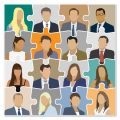Introduction to Multigenerational Teams
Today’s American workplaces are more age-diverse than ever before. Many organizations now have employees from four or even five different generations working side by side. This mix of ages is known as a multigenerational team. Understanding what defines a multigenerational team and why age diversity matters can help companies create more inclusive and effective work environments.
What Is a Multigenerational Team?
A multigenerational team is a group of employees from different age groups collaborating toward common goals. In the U.S., these generations are often described as:
| Generation | Birth Years (Approximate) | Key Traits |
|---|---|---|
| Traditionalists | Before 1946 | Loyal, disciplined, value experience |
| Baby Boomers | 1946–1964 | Hardworking, team-oriented, motivated by achievement |
| Generation X | 1965–1980 | Independent, flexible, value work-life balance |
| Millennials (Gen Y) | 1981–1996 | Tech-savvy, purpose-driven, collaborative |
| Generation Z | 1997–2012 | Digital natives, entrepreneurial, value diversity and inclusion |
The Current Landscape of Age Diversity in American Workplaces
The workforce in the United States is aging overall, but younger generations are also entering the job market in large numbers. As Baby Boomers delay retirement and Generation Z begins their careers, companies find themselves managing teams that span decades of experience and perspectives. According to the U.S. Bureau of Labor Statistics, about one-fourth of workers are aged 55 or older, while Millennials make up the largest segment of the workforce.
Why Does Age Diversity Matter?
Having a mix of generations at work brings together people with different skills, values, and ways of thinking. This diversity can spark creativity and innovation, but it can also lead to misunderstandings if not managed well. Recognizing the unique contributions of each generation helps foster respect and teamwork across all age groups.
2. Key Benefits of Age Diversity
Bringing Together Unique Strengths
When people from different generations work together, they each bring their own unique strengths to the team. Older employees often have years of industry experience and deep knowledge, while younger team members may be more comfortable with new technologies and fresh approaches. This mix can make teams stronger and more adaptable.
How Each Generation Contributes
| Generation | Unique Strengths | Typical Skills |
|---|---|---|
| Baby Boomers | Work ethic, reliability, mentorship | Industry expertise, relationship building |
| Generation X | Adaptability, independence, problem-solving | Project management, communication skills |
| Millennials | Tech-savvy, collaborative, purpose-driven | Digital skills, teamwork, creativity |
| Generation Z | Innovation, diversity mindset, fast learners | Social media expertise, adaptability to change |
Diverse Perspectives Fuel Innovation
A team with a wide age range is more likely to come up with creative solutions. Different perspectives mean that problems are approached in new ways. For example, a Gen Z employee might suggest using a new digital tool to solve a problem, while a Baby Boomer could share lessons learned from past experiences to avoid common mistakes.
The Power of Collaboration Across Ages
When employees from various generations share ideas and work together on projects, it leads to better decision-making and more effective problem-solving. Teams can draw on the wisdom of experienced workers as well as the innovative thinking of younger colleagues. This blend often results in stronger outcomes for businesses.
![]()
3. Challenges of Managing Multigenerational Teams
Communication Gaps
One of the most common challenges in multigenerational teams is communication gaps. Different age groups often have their own preferred ways of communicating. For example, Baby Boomers might prefer face-to-face meetings or phone calls, while Millennials and Gen Z may lean towards instant messaging or emails. These differences can lead to misunderstandings or missed information, impacting the overall effectiveness of the team.
Common Communication Preferences by Generation
| Generation | Preferred Communication Style |
|---|---|
| Baby Boomers | Face-to-face, phone calls |
| Gen X | Email, phone calls |
| Millennials | Texting, instant messaging, email |
| Gen Z | Instant messaging, video chats, social media |
Differing Work Styles
Work styles can vary a lot between generations. Some team members may value structure and traditional work hours, while others are more comfortable with flexible schedules and remote work. These differences can sometimes lead to frustration or conflict if not managed carefully.
Examples of Work Style Differences
| Generation | Typical Work Style Preference |
|---|---|
| Baby Boomers | Structured tasks, clear hierarchy, set hours |
| Gen X | Autonomy, work-life balance, results-oriented |
| Millennials & Gen Z | Collaboration, flexibility, tech-driven approaches |
Varying Expectations and Values
Differing expectations about feedback, recognition, and career advancement are also common obstacles. Older generations may expect formal annual reviews and long-term loyalty to one company. Younger employees might look for frequent feedback and faster career progression. When these expectations clash, it can affect motivation and job satisfaction within the team.
The Impact on Team Cohesion
If these challenges arent addressed, they can cause friction among team members and reduce overall team cohesion. Misunderstandings or unmet expectations may lead to lower trust and collaboration. Its important for managers to recognize these potential issues early and encourage open communication to help bridge gaps between generations.
4. Strategies for Fostering Collaboration
Building Trust Across Generations
Trust is the foundation of any successful team, especially in a multigenerational workplace. Leaders and team members can take practical steps to build trust by encouraging open communication, showing respect for different viewpoints, and recognizing the unique contributions of each age group. Regular team meetings where everyone has the chance to speak and share their ideas help break down barriers and create a safe space for honest conversations.
Encouraging Knowledge Sharing
Each generation brings different skills and experiences to the table. To maximize these strengths, it’s important to create opportunities for knowledge sharing. This can be done through mentoring programs, cross-generational project teams, or simple lunch-and-learn sessions where employees share insights on topics they are passionate about.
| Strategy | Description | Example |
|---|---|---|
| Reverse Mentoring | Younger employees mentor older colleagues on technology or new trends. | A Gen Z employee helps a Baby Boomer with social media tools. |
| Traditional Mentoring | Experienced team members guide younger employees in professional development. | A Gen X manager coaches Millennials on leadership skills. |
| Peer Learning Groups | Small groups from various generations work together to solve problems. | A mixed-age task force brainstorms ways to improve customer service. |
Promoting Active Engagement for All Ages
Engagement happens when everyone feels heard and valued. Leaders should invite input from all age groups during meetings and decision-making processes. Rotating meeting facilitators among different generations gives everyone a sense of ownership. Celebrating achievements—big or small—fosters motivation and shows appreciation for diverse efforts.
Tips for Daily Collaboration
- Use clear, inclusive language: Avoid jargon that may be unfamiliar to some age groups.
- Be flexible with communication styles: Offer both digital and face-to-face options as preferred by team members.
- Set shared goals: Align team objectives so everyone works toward common outcomes.
- Create feedback loops: Encourage regular check-ins so all voices are heard and adjustments can be made quickly.
The Role of Leadership in Multigenerational Teams
Leaders play a key role in setting the tone for collaboration. By modeling respect, curiosity, and adaptability, leaders inspire team members to do the same. Providing training on generational diversity and facilitating open dialogues helps everyone understand each other better and work together more effectively.
5. The Future of Multigenerational Workplaces
Demographic Shifts and Team Dynamics
As people live and work longer, its becoming more common to see teams made up of employees from four or even five generations. This mix brings fresh ideas, different life experiences, and a variety of working styles to the table. At the same time, it can also create new challenges as expectations around communication, technology, and work-life balance continue to change.
Predictions for the Modern Workplace
| Trend | Potential Impact on Teams |
|---|---|
| Remote & Hybrid Work | Younger generations may prefer digital collaboration tools, while older workers might value face-to-face interaction. Finding the right balance will be key. |
| Lifelong Learning | All generations will need to adapt and learn new skills as technology evolves. Mentorship and reverse mentorship programs can help bridge gaps. |
| Diversity & Inclusion Initiatives | Companies that prioritize age diversity alongside other forms of inclusion will have a competitive advantage in attracting talent. |
| Flexible Career Paths | The traditional career ladder is giving way to personalized career journeys. Employers may offer flexible roles or part-time options to keep experienced talent engaged. |
How Organizations Can Stay Inclusive and Competitive
- Create Open Channels for Feedback: Encourage team members of all ages to share their perspectives regularly.
- Invest in Training: Offer workshops on new technologies and soft skills that benefit every generation.
- Celebrate Differences: Highlight success stories where multigenerational teams have solved tough problems together.
- Offer Flexible Work Options: Recognize that different generations may have different needs for work hours or locations.
- Update Policies Regularly: Review workplace policies with an eye toward fairness and inclusivity as demographics shift.
The Path Forward
The future of multigenerational workplaces will be shaped by both demographic changes and shifting attitudes about how, when, and where we work. Companies that embrace these changes—by valuing every generations strengths and creating supportive environments—will be best positioned for success in tomorrow’s workforce.

